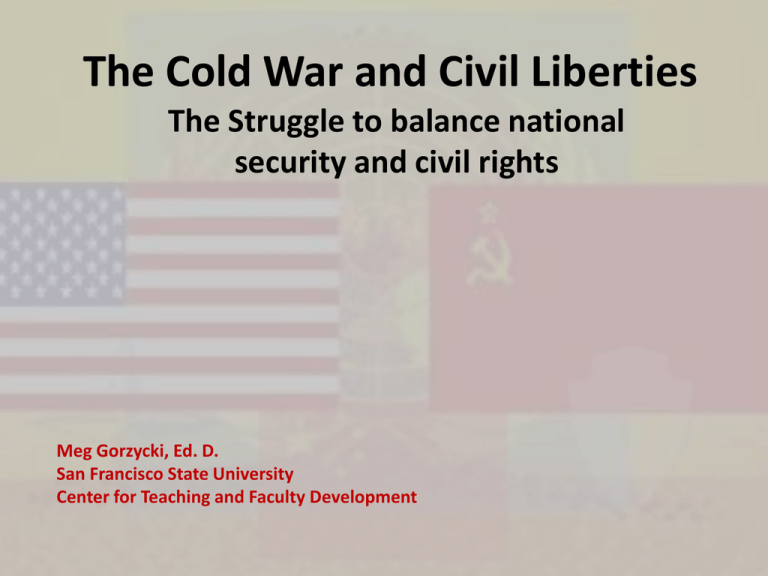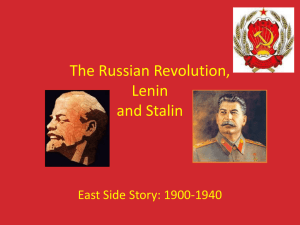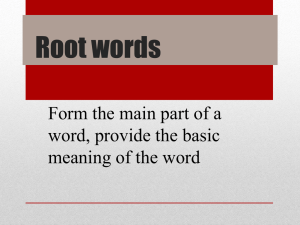The Cold War and Civil Liberties - The Center for Teaching and
advertisement

The Cold War and Civil Liberties The Struggle to balance national security and civil rights Meg Gorzycki, Ed. D. San Francisco State University Center for Teaching and Faculty Development Define Cold War • Ideological contest between communism and capitalism, 1945-1991 • Conflict between USA and USSR over which would influence development of other nations • Space race and as example of competition between USA and USSR to dominate development of new technology • Arms race to ensure military dominance Seeds of Socialism: 19th Century • Industrial revolution • Child labor • Poor wages • No health care • No pensions • Unregulated banking • Unregulated manufacturing Seeds of Socialism: 19th Century • Unions created • Reforms demanded • New political theories including anarchism and socialism Roots of Cold War: World War I • Germany brutally defeats Russia on Eastern Front • Espionage Act, 1917 amended many times to prosecute traitors, pacifists and socialists in US Roots of Cold War: Vladimir Lenin • Lenin led revolutionaries to overthrow the Czar • Lenin taught Russians the war was a capitalist venture • Lenin consolidated state control of the economy Roots of Cold War: Joseph Stalin • Stalin ruled the Soviet Union from 1927-1953 • Conducted purges during 1930s • Collectivized farms and proliferated industrialization Roots of Cold War: Anti-Bolshevism • • • • Red scare 1920s and 30s Fear of labor unions Fear of immigrants Propaganda against socialism Roots of Cold War: FBI &HUAC • Federal Bureau of Investigation (FBI) fights labor unions • J. Edgar Hoover (Director) 1924-1973. • 1938 House Committee on Un-American Activities (HUAC) Roots of Cold War: World War II The United States and the Soviet Union were allies in World War II Cold War: Soviet Victories • Soviets take Berlin, 1945 • Soviets consolidate control over Eastern Europe Cold War: Containment • 1947 National Security Act (CIA and National Security Council) • Containment policy • Marshall Plan • Atomic proliferation • NATO • Loyalty oaths Cold War: Blacklist • 1946 Blacklisting begins in Hollywood • Hollywood Ten called before HUAC • 1957 non-cooperation begins with CBS • HUAC divides entertainment industry Cold War: Target Writers and Artists • • • • • • • • • • • • • • • • Jane Adams W.E.B. Dubois Lillian Hellman Ray Bradbury Allen Ginsburg Charlie Chaplin James Baldwin Ernest Hemmingway Joseph Alsop Bertolt Brecht Pearl Buck Truman Capote Margaret Chung Paul Goodman Rock Hudson Jerome Robins Paul Robeson Gore Vidal Tennessee Williams Andy Warhol Walter Winchell T. S. Elliot Ezra Pound Upton Sinclair James Joyce Marianne Moore Lorraine Hansberry Langston Hughes Leonard Bernstein Norma Mailer John Lennon Groucho Marx Christopher Isherwood Danny Kaye Georgia O’Keefe Cold War: Homophobia • Gay men and women were thought especially dangerous to national security • They were especially vulnerable to blackmail Cold War: Propaganda • God was on capitalism’s side • Communism was the devil’s work • Communists subverted the family Cold War: Cinema Cold War: Academia • Cold War challenged limits of academic freedom • Campuses became research centers for government projects including weapons development Cold War: Civil Rights Movement Civil rights advocates frequently accused of being communist in order to discredit their demands and critique of American society Cold War: Anti-War Movement Stereotype: “Peaceniks” are anti-American, lazy, ignorant, college kids, bums, and communists Reality: Opponents of the war include veterans, religious ministers, and working citizens of all ages and parties Cold War: Challenged • 1971, Daniel Ellsberg, veteran and Rand analyst disclosed secret files about U.S. agenda in Vietnam • 1971, New York Times Co. v. United States: Supreme Court ruled Nixon could not impose prior restraint on newspapers carrying Pentagon papers Cold War: Détente 1972-1979 • Arms negotiations • Cultural exchanges • Complicated by wars in Vietnam and Middle East • Soviet invasion Afghanistan, 1979 Cold War: Ends • Mikhail Gorbachev Communist General Party Secretary, 19851991 • Glastnost & Peristroika • Strategic Defense Initiative • End Breshnev Doctrine • Berlin Wall 1989 • End Afghan War, 1989 • Dissolve USSR 1991 National Security: Since 9-11 • Islamic fundamentalism as the new menace of the free world • Sustained investment in weapons development • Patriot Act restricts civil liberties National Security State: Business Good Communists Bad Communists Red-Baiting in 21st Century What do these labels really mean? Review and Discussion 1. What was the Cold War’s impact on civil liberties? 2. How did the state justify the restriction of liberty? 3. What role did the media play in the conflict between national security and civil liberties? 4. Why did some people support authorities who enforced strict national security laws and why did some not? 5. What is the citizens obligation relative to national security? 6. What are some things that complicate the citizen’s obligation to protect national security? 7. In what ways are current American values and attitudes towards the world similar to the those of the Cold War, and what does this indicate about civil liberties? References Craig, C. & Logevall, F. (2009). America’s cold war: The politics of insecurity. Cambridge, MA: The President and Fellows of Harvard College. Doherty, T. (2005). Cold War, cool medium: Television, McCarthyism and American Culture. New York, NY: Columbia University Press. Dudziak, M. L. (2000). Cold War Civil Rights: Race and the image of American democracy. Princeton, NJ: Princeton university press. Gaddis, J. L. (2006). The Cold War A new history. New York, NY: Penguin Books. Hoffman, D. E. (2009). The dead hand: The untold story of the cold war arms race and its dangerous legacy. New York, NY: Anchor books. Katzenstein, P.J. (Ed.) (1996). The culture of national security. New York, NY: Columbia Press. Kuznick, J. & Gilbert, J. (Eds.) (2001). Rethinking Cold War culture. Washington, D. C.: Smithsonian Books. McCumber, J. (2001). Time in the Ditch. American Philosophy and the McCarthy Era. Northwestern University Press. Painter, D. S. (1999). The Cold War: An international history. New York, NY: Routledge. Schrecker, E. (1986). No Ivory Tower. McCarthyism and the University. Oxford University Press. Seldes, G. (1940/2012). Witch hunt: The techniques and profits of red-baiting. CreateSpace Independent Publishing Platform. Stouffer, S. A. (1955/2009). Communism, conformity and civil liberties: A cross section of the nation speaks it mind. New Brunswick, NJ: Transaction Publishers. Archival information about national security may be found at: http://www.archives.gov/research/. They may also be located at the CIA website: https://www.cia.gov/index.html. De-classified material pertaining to the cold War may be found at http://www.gwu.edu/~nsarchiv/coldwar/documents/. Film clip form documentary about Hollywood Ten (1950) http://www.youtube.com/watch?v=taancRcLQ8o. Anti-communist propaganda cartoon : http://www.youtube.com/watch?v=g_DaMKUP3Og.











